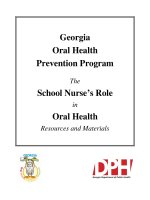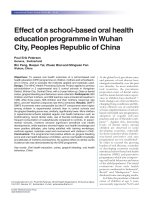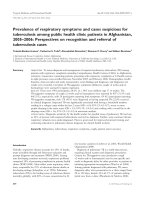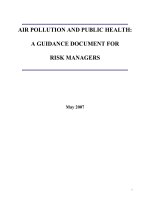Societal Burden of Child Maltreatment and Public Health’s Role in Prevention docx
Bạn đang xem bản rút gọn của tài liệu. Xem và tải ngay bản đầy đủ của tài liệu tại đây (1.59 MB, 58 trang )
1
Societal Burden of Child Maltreatment and
Public Health’s Role in Prevention
James A. Mercy, PhD
Acting Director, Division of Violence Prevention
National Center for Injury Prevention and Control
Centers for Disease Control and Prevention
Long-standing interest in child maltreatment
Atlanta child murder investigation, 1980
CDC work has expanded with Congressional appropriations
over past 10 years - $7 million in FY2011
CDC and Child Maltreatment
Epidemiologic Analysis of a
Cluster of Homicides of
Children in Atlanta
Blaser, MJ et al. JAMA 1984;251:3255 –3258
2
Child Maltreatment
3
Acts of commission (abuse) or omission (neglect)
by a parent or other caregiver
that result in harm, potential for harm,
or threat of harm to a child
Children
<18 years
Caregivers
Anyone responsible for care and control, overall health, and
welfare of a child
Types of maltreatment
Physical, sexual, psychological abuse, and neglect
Leeb, RT et al. Child Maltreatment Surveillance: Uniform Definitions for Public Health and Recommended Data Elements, Version 1.0.
Atlanta (GA): Centers for Disease Control and Prevention, National Center for Injury Prevention and Control; 2007.
4
How Common Is Child Maltreatment?
In 2009, 1,770 CHILDREN DIED as a
result of maltreatment
= 5 children died every day
= 71 classrooms
More than 80% were <4 years
Abusive head trauma a major cause
U.S. Department of Health and Human Services, Administration for Children and Families, Administration on Children, Youth and Families, Children’s
Bureau. (2010). Child Maltreatment 2009. Available from />5
How Common Is Child Maltreatment?
U.S. Department of Health and Human Services, Administration for Children and Families, Administration on Children, Youth and Families, Children’s
Bureau. (2010). Child Maltreatment 2009. Available from
Finkelhor, D et al. Pediatrics 2009;124:1411-1423
State Child Protective Service data, 2009
6 million reports of alleged child maltreatment
702,000 confirmed cases of child maltreatment
Self-report data on maltreatment experience, 2008
In past year: 1 of 10 or 7.5 million children
At some point during childhood: 1 of 5 or 15 million children
6
Risk increases with age
Children <4 years are at greatest risk of severe injury
Children with special needs that may increase
caregiver burden
Learning disabilities
Mental retardation
Mental health issues
Chronic physical illness
Which Children are Most Vulnerable?
7
Better Data Are Needed to Track Child Maltreatment
Child Protective Service data is the mainstay of
child maltreatment surveillance, BUT
Child maltreatment is underestimated by a factor of 10
Epidemiology of the problem is distorted
New methods are needed to track the magnitude of child
maltreatment
Surveys of children and parents
Better use of hospital discharge and emergency department data
8
Risk Factors for Child Maltreatment Perpetration
Community Family Individual
Young age
Lack of understanding of children’s needs
Single parenthood
Substance abuse
Mental health issues
Cognitions that justify maltreatment
Low income/education
History of being maltreated as a child
Social isolation
Large number of children
Family disorganization, dissolution, and violence
Caregiver stress
Community violence
High poverty
Residential instability
High density of alcohol outlets
High unemployment
Poor social connections
Death
Birth
Child maltreatment
Social, emotional, and cognitive
Impairments
Adoption of
health-risk behaviors
Disease,
injury, and
disability
Early
death
The Influence of Child Maltreatment throughout Life
9
Consequences of Child Maltreatment
Health-risk Behaviors
Sexual promiscuity
Sexual perpetration
Alcohol abuse
Illicit/injected-drug use
Smoking
Social, Emotional, and
Cognitive Impairments
Depression, post-traumatic stress
disorder (PTSD)
Aggression
Anxiety
Somatic complaints
Attempted suicide
Social ostracism
Anxiety
Academic achievement
Re-victimization
Unwanted pregnancy
Disease, Injury, and
Disability
STDs, including HIV
Gynecological problems
Heart disease
Diabetes
Stroke
Cancer
Suicide
10
The Adverse Childhood Experiences Study
Adverse Childhood Experiences (ACEs)
Physical, sexual, and emotional maltreatment, and growing up with
Intimate partner violence against mother
Household substance abuse, mental illness or suicidality
Parental separation or divorce
Household member in prison
ACE score
Number of exposures to the different types of adverse experiences that
occurred to a respondent as a child
ACE study
Retrospective cohort study of >17,000 participants
HMO population Kaiser Permanente in San Diego
Impact of ACEs on health throughout the lifespan
Felitti, VJ et al. American Journal of Preventive Medicine 1998;14:245–258
11
ACE Score and Adult Depression
0
1
2
3
4
5
6
Adjusted odds ratio
Number of ACEs
12
ACE, Adverse childhood experience
Chapman, DP et al. Journal of Affective Disorders 2004;82:217–225
Gonzalez, O et al. MMWR 2010;59(38):1229-1235
1 2 3 4 ≥50
0
0.5
1
1.5
2
2.5
3
3.5
Adjusted odds ratio
ACE Score and Adult Cardiovascular Disease
13
ACE, Adverse childhood experience
Dong, M et al. Circulation 2004;110:1761–1766.
Number of ACEs
1 2 3 4 5,60
7,8
ACE Score and HIV Risks
0
2
4
6
8
10
12
0 1 2 3 ≥4
Number of ACEs
Ever-injected drugs Had ≥50 intercourse partners Ever had an STD
14
ACE, Adverse childhood experience
Felitti, VJ et al. American Journal of Preventive Medicine 1998;14:245–258
Adjusted odds ratio
Child Maltreatment Compromises
Early Brain Development
Excessive, repeated stress causes the release
of chemicals that
Impair cell growth and the formation of healthy neural circuits
Damage the brain’s stress response system
Contribute to premature aging of the body
Healthy Brain
Abused Brain
National Scientific Council on the Developing Child, Excessive Stress Disrupts the Architecture of the Developing Brain.
Working Paper No. 3. [online] 2005 [cited 2006 Aug 10]. Available from: www.developingchild.net/reports.shtmlc
15
16
Lifetime Economic Burden
of Child Maltreatment: $121 billion in 2008
20.2%
69.2%
3.6%
3.2%
3.7%
Economic burden
Productivity losses
Health care costs
Special education costs
Criminal justice costs
Child welfare costs
Fang X, et al. The economic burden of child maltreatment in the United States. Under review, 2011
17
Reduction in Annual Earnings
from Selected Health Events (2009 Dollars)
$5,855
$2,306
$1,129
$1,938
$0 $1,000 $2,000 $3,000 $4,000 $5,000 $6,000 $7,000
Child maltreatment
Smoking
Teen pregnancy
Obesity
Fang X, et al. The economic burden of child maltreatment in the United States. Under review, 2011
Reduction in annual earnings
Challenges to Reducing Child Maltreatment
18
Broad range of short-term and long-term health
consequences are underappreciated
Absence of a valid and reliable surveillance system
As a society we have not prioritized primary prevention but
invested largely in response through the child welfare
system
Public health is not well integrated into a coordinated
prevention system
CDC Approaches
to Reducing Child Maltreatment
19
Bringing focus to evidence-driven prevention by
Raising visibility about health
consequences and costs
Ensuring the availability of valid and
reliable data
Filling gaps in the evidence base by
moving the field toward environmental,
population-based interventions
Strengthening and mobilizing the public
health system
The Importance of Viewing Child Maltreatment in
a Broad Societal Context
The healthy development of all children
benefits society by providing
a solid foundation for economic productivity,
responsible citizenship, strong communities,
and a secure nation
20
21
Prevention Works!
Janet R. Saul, PhD
Acting Special Advisor, Division of Violence Prevention
National Center for Injury Prevention and Control
Centers for Disease Control and Prevention
Addressing Child Maltreatment in the United States
Current System
22
Involvement in
foster care and court system
Services for families and children
who have experienced
maltreatment
Targeted services for
children and families
at risk
Universal preventive
initiatives to support all
families and children
23
Addressing Child Maltreatment in the United States
Ideal System
Involvement in
foster care and court system
Services for families and
children who have experienced
maltreatment
Targeted services for
children and families
at risk
Universal preventive
initiatives to support all
families and children
CDC’s Role in Child Maltreatment Prevention
Ensuring Safe, Stable, and Nurturing Relationships
(SSNRs) for ALL Children
Safety
Freedom from fear
Security from physical or psychological harm
Stability
Predictability and consistency
Nurturing
Sensitive and consistent response
to the child’s needs
24
Long-a.pdf
SSNRs go beyond parents
Other caregivers and important adults
Environments conducive to SSNRs
SSNRs are based on scientific
literature
Healthy development depends on the
quality and reliability of children’s
relationships
Builds healthy brain architecture
Provides foundation for learning, positive
behavior, and health
25
Long-a.pdf
CDC’s Role in Child Maltreatment Prevention
Ensuring Safe, Stable, and Nurturing Relationships
(SSNRs) for ALL Children









